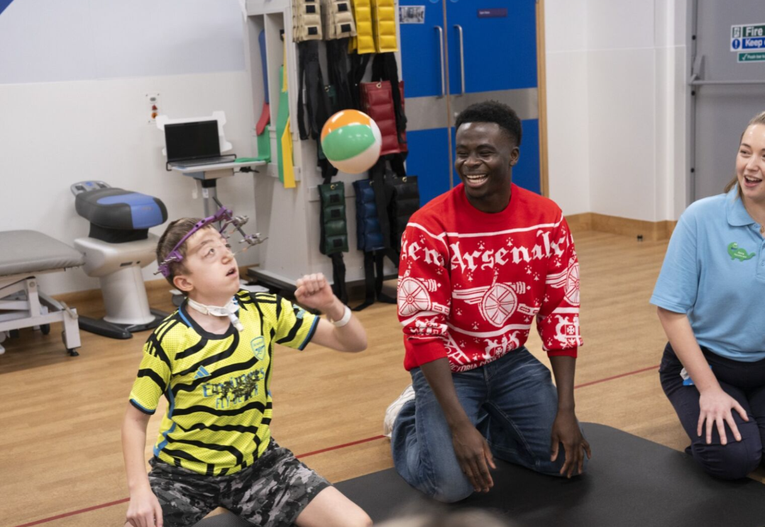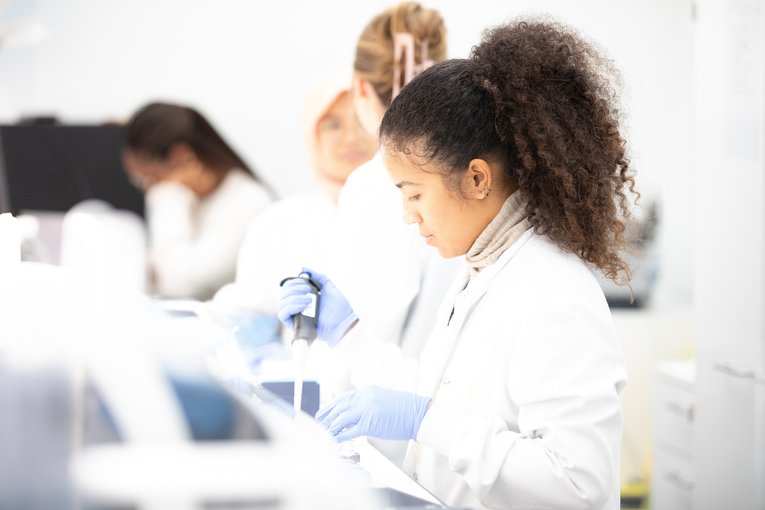
https://www.gosh.nhs.uk/news/gosh-research-and-innovation-image-competition-a-moment-of-discovery/
Stunning images showcase life-changing research at GOSH
28 Feb 2023, 9 a.m.
A captivating 3D image that is helping researchers to uncover the secrets of childhood cancers is crowned the winner of our 2022/23 image competition ‘A moment of discovery’.
Staff were from across Great Ormond Street Hospital (GOSH), and its affiliated institutes including the National Institute for Health and Care Research GOSH Biomedical Research Centre (NIHR GOSH BRC) and University College London Great Ormond Street Institute of Child Health (UCL GOS ICH) were invited to submit an image that captures a ‘moment’ of their life changing research. This year the competition was also opened to children’s hospitals across the UK within the NIHR GOSH BRC Paediatric Excellent Initiative, including Alder Hey, Birmingham and Sheffield.
11 images, gifs and videos which illustrate the breadth of transformative research connected to GOSH were shortlisted and put before three panels – the GOSH Young People's Advisory Group for research (YPAG), NIHR GOSH BRC stakeholders and the GOSH staff networks. Each panel chose a favourite, and these three favourites were put to the public who voted for an overall winner via social media.
After hundreds of votes across social media platforms, the image crowned the winner was ‘A 3D snapshot of the hidden highways in childhood kidney cancer', entered by a team of multidisciplinary researchers at GOSH and UCL GOSH ICH.
Overall winner and YPAG favourite: A 3D snapshot of the hidden highways in childhood kidney cancer

A 3D snapshot of the hidden highways in childhood kidney cancer
The winning image was entered by Dr Daniyal Jafree, UCL GOS ICH Postdoctoral Researcher, Radu Polschi, UCL Medical Student, Aleksandra Letunovska, UCL GOS ICH Biomedical Scientist, and Reem Al-Saadi, UCL GOS ICH Senior Research Associate.
This tangle of blues and purples peppered with gold, shows the lymph network (blue) within a kidney tumour alongside other structures such as blood vessels (purple) and immune cells (yellow). These ‘hidden highways’ are usually responsible for waste disposal, however cancers can hijack the system and use them to spread tumour cells around the body.
These systems are incredibly hard to see using traditional microscope techniques. Through collaboration, the team brought their unique skills together to generate this image using a new 3D imaging technique to view the lymph network within the tumour in high detail, to better understand how cancers grow and spread.
The team behind the image

Pictured: Professor David Long, Professor of Paediatric Nephrology, UCL GOS ICH, Dr Ciaran Hutchinson, Consultant in Paediatric & Perinatal Pathology, GOSH, Dr Daniyal Jafree, Postdoctoral Research Fellow, UCL GOS ICH, Dr Dale Moulding, Senior Research Fellow, UCL GOS ICH, Ms Reem Al-Saadi, Senior Translational Research Manager, UCL GOS ICH, Ms Aleksandra Letunovska, Biomedical Scientist, UCL GOS ICH, Mr Radu Polschi, Medical Student, UCL.
Pictured above are just some of the team that helped to create the winning image. The multidisciplinary team are looking at how cancers grow and spread through lymph networks. The hope is that this will help them understand whether the size of the network can predict how well children respond to chemotherapy, or if these highways influence the likelihood of cancer spread.
This image, and the teams hard work behind it, is an example of how research and innovation is only possible through collaboration.
I’ve been working at UCL Great Ormond Street Institute of Child Health for 7 years, and in that time, two things have become very clear. Firstly, it’s so important that we communicate our research to the people we ultimately hope to benefit: patients, their families and the public.
Secondly, none of our research would be possible without a big team of scientists and clinical professionals, all with different backgrounds and experiences, all sharing the common goal of improving diagnosis and treatment for childhood diseases and cancer.
The team and I are so thrilled that our image, which showcases just how important these two things are to research and innovation, was voted as favourite by the public.
GOSH Staff Network’s favourite: Stimulating the brain, an evolving treatment for children with drug-resistant seizures

Stimulating the brain: an evolving treatment for children with drug-resistant seizures
Entered by Rory Piper, Lewis Spitz Surgeon Scientist PhD Student, this image resembling the features of a lion has captured the cross-section of a simulated brain used to help study potential treatments for epilepsy in children.
Deep brain stimulation (DBS) is a type of brain surgery that uses electrical pulses to change the way the brain works. This treatment can be helpful in certain brain conditions, such as epilepsy, in which the brain's electrical activity is abnormal and needs to be corrected or changed. Here, a representative cross-section of the brain (looking from front to back) shows two DBS wires implanted in the thalamic regions (blue), which are parts of the brain involved in the routing of electrical signals.
NIHR GOSH BRC Partners’ favourite: Nasal COVID-19 factories

Nasal COVID-19 factories
Entered by Dr Maximillian Woodall, UCL GOS ICH Research Fellow, Dr Samuel Ellis, UCL GOS ICH Research Fellow and Dr Andreia Pinto, Leica Microsystems, this striking collection of shapes and colours shows human nose cells infected with SARS-CoV-2 (viral particles in red). It was taken as part of a study investigating how SARS-CoV-2 (Covid) infection differs with age.
From the image, it is possible to see that some cells, such as epithelial cells (dark green) are much more susceptible to infection than others like mucus secreting cells (yellow).
Scroll through the full shortlist below
Lasting impressions
We heard from some of our shortlisting panel members what these images mean to them:
These pictures made me realise how science is beautiful in every aspect.
These images are stunningly beautiful and vivid reminders how intricately organised the microcosm of biology is.
Being on this panel has made me so proud of the immense skill, hard work, dedication and innovation that's taking place every day at GOSH. It's a real privilege to see these amazing images and to read about the work they represent.
Showcasing our research
All shortlisted images are being exhibited in the entrance of the Zayed Centre for Research into Rare Disease in Children (ZCR).
These are available to view from the street, along with a one-of-a-kind laboratory in a dropped floor that is home to the researchers that work on some of the most rare and complex conditions in children.

Arsenal stars bring festive cheer to patients, families and staff
GOSH was buzzing with excitement this month as players from Arsenal’s men’s and women’s first‑team squads paid a special visit to children, families, and staff.

NIHR launches £13.7m investment into brain tumour research
The National Institute for Health and Care Research (NIHR) has announced a £13.7 million investment that will support ground-breaking research to develop novel brain tumour treatments in the UK.

New consortium aims to help improve care for arthritis patients
A new UK-led research group, including Great Ormond Street Hospital and University College London, aims to improve the lives of children, young people and adults with arthritis by defining for the first time what being in ‘remission’ from arthritis truly

Update for patients and families on industrial action - December 2025
As you may be aware, some of our Resident Doctors will be taking part in planned industrial action from 7am on Wednesday 17 December to 7am on Monday 22 December.







